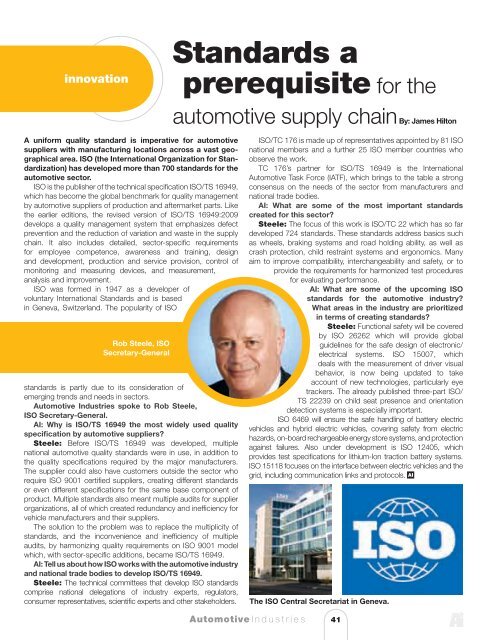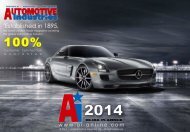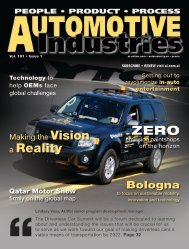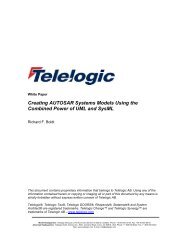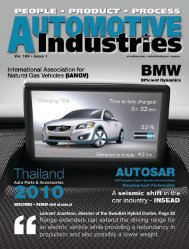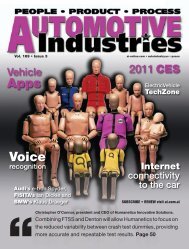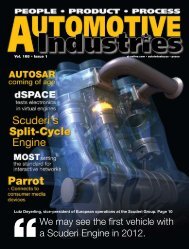engineering, AUTOSAR - Automotive Industries
engineering, AUTOSAR - Automotive Industries
engineering, AUTOSAR - Automotive Industries
Create successful ePaper yourself
Turn your PDF publications into a flip-book with our unique Google optimized e-Paper software.
innovation<br />
A uniform quality standard is imperative for automotive<br />
suppliers with manufacturing locations across a vast geographical<br />
area. ISO (the International Organization for Standardization)<br />
has developed more than 700 standards for the<br />
automotive sector.<br />
ISO is the publisher of the technical specification ISO/TS 16949,<br />
which has become the global benchmark for quality management<br />
by automotive suppliers of production and aftermarket parts. Like<br />
the earlier editions, the revised version of ISO/TS 16949:2009<br />
develops a quality management system that emphasizes defect<br />
prevention and the reduction of variation and waste in the supply<br />
chain. It also includes detailed, sector-specific requirements<br />
for employee competence, awareness and training, design<br />
and development, production and service provision, control of<br />
monitoring and measuring devices, and measurement,<br />
analysis and improvement.<br />
ISO was formed in 1947 as a developer of<br />
voluntary International Standards and is based<br />
in Geneva, Switzerland. The popularity of ISO<br />
Rob Steele, ISO<br />
Secretary-General<br />
standards is partly due to its consideration of<br />
emerging trends and needs in sectors.<br />
<strong>Automotive</strong> <strong>Industries</strong> spoke to Rob Steele,<br />
ISO Secretary-General.<br />
AI: Why is ISO/TS 16949 the most widely used quality<br />
specification by automotive suppliers?<br />
steele: Before ISO/TS 16949 was developed, multiple<br />
national automotive quality standards were in use, in addition to<br />
the quality specifications required by the major manufacturers.<br />
The supplier could also have customers outside the sector who<br />
require ISO 9001 certified suppliers, creating different standards<br />
or even different specifications for the same base component of<br />
product. Multiple standards also meant multiple audits for supplier<br />
organizations, all of which created redundancy and inefficiency for<br />
vehicle manufacturers and their suppliers.<br />
The solution to the problem was to replace the multiplicity of<br />
standards, and the inconvenience and inefficiency of multiple<br />
audits, by harmonizing quality requirements on ISO 9001 model<br />
which, with sector-specific additions, became ISO/TS 16949.<br />
AI: Tell us about how ISO works with the automotive industry<br />
and national trade bodies to develop ISO/TS 16949.<br />
steele: The technical committees that develop ISO standards<br />
comprise national delegations of industry experts, regulators,<br />
consumer representatives, scientific experts and other stakeholders.<br />
standards a<br />
prerequisite for the<br />
automotive supply chain By: James Hilton<br />
ISO/TC 176 is made up of representatives appointed by 81 ISO<br />
national members and a further 25 ISO member countries who<br />
observe the work.<br />
TC 176’s partner for ISO/TS 16949 is the International<br />
<strong>Automotive</strong> Task Force (IATF), which brings to the table a strong<br />
consensus on the needs of the sector from manufacturers and<br />
national trade bodies.<br />
AI: What are some of the most important standards<br />
created for this sector?<br />
steele: The focus of this work is ISO/TC 22 which has so far<br />
developed 724 standards. These standards address basics such<br />
as wheels, braking systems and road holding ability, as well as<br />
crash protection, child restraint systems and ergonomics. Many<br />
aim to improve compatibility, interchangeability and safety, or to<br />
provide the requirements for harmonized test procedures<br />
for evaluating performance.<br />
AI: What are some of the upcoming ISO<br />
standards for the automotive industry?<br />
What areas in the industry are prioritized<br />
in terms of creating standards?<br />
steele: Functional safety will be covered<br />
by ISO 26262 which will provide global<br />
guidelines for the safe design of electronic/<br />
electrical systems. ISO 15007, which<br />
deals with the measurement of driver visual<br />
behavior, is now being updated to take<br />
account of new technologies, particularly eye<br />
trackers. The already published three-part ISO/<br />
TS 22239 on child seat presence and orientation<br />
detection systems is especially important.<br />
ISO 6469 will ensure the safe handling of battery electric<br />
vehicles and hybrid electric vehicles, covering safety from electric<br />
hazards, on-board rechargeable energy store systems, and protection<br />
against failures. Also under development is ISO 12405, which<br />
provides test specifications for lithium-Ion traction battery systems.<br />
ISO 15118 focuses on the interface between electric vehicles and the<br />
grid, including communication links and protocols. AI<br />
The ISO Central Secretariat in Geneva.<br />
<strong>Automotive</strong> <strong>Industries</strong> 41


